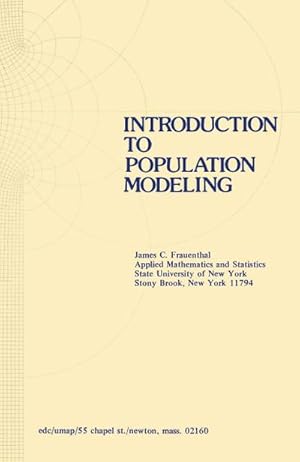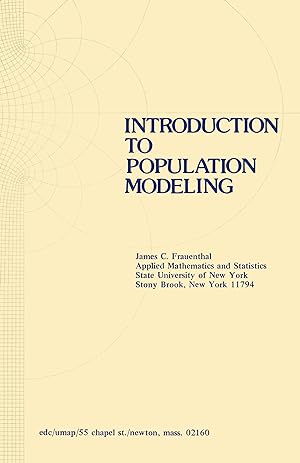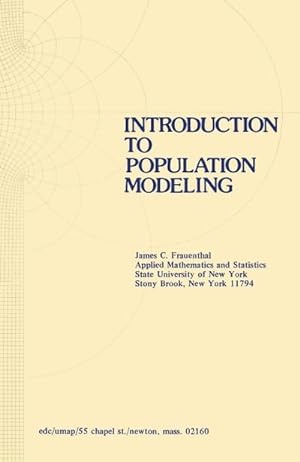introduction population modeling de frauenthal j c (11 résultats)
Filtres de recherche
Type d'article
- Tous les types de produits
- Livres (11)
- Magazines & Périodiques (Aucun autre résultat ne correspond à ces critères)
- Bandes dessinées (Aucun autre résultat ne correspond à ces critères)
- Partitions de musique (Aucun autre résultat ne correspond à ces critères)
- Art, Affiches et Gravures (Aucun autre résultat ne correspond à ces critères)
- Photographies (Aucun autre résultat ne correspond à ces critères)
- Cartes (Aucun autre résultat ne correspond à ces critères)
- Manuscrits & Papiers anciens (Aucun autre résultat ne correspond à ces critères)
Etat En savoir plus
- Neuf (10)
- Comme neuf, Très bon ou Bon (Aucun autre résultat ne correspond à ces critères)
- Assez bon ou satisfaisant (1)
- Moyen ou mauvais (Aucun autre résultat ne correspond à ces critères)
- Conformément à la description (Aucun autre résultat ne correspond à ces critères)
Reliure
- Toutes
- Couverture rigide (Aucun autre résultat ne correspond à ces critères)
- Couverture souple (11)
Particularités
- Ed. originale (Aucun autre résultat ne correspond à ces critères)
- Signé (Aucun autre résultat ne correspond à ces critères)
- Jaquette (Aucun autre résultat ne correspond à ces critères)
- Avec images (5)
- Sans impressions à la demande (7)
Langue (1)
Prix
- Tous les prix
- Moins de EUR 20 (Aucun autre résultat ne correspond à ces critères)
- EUR 20 à EUR 45 (Aucun autre résultat ne correspond à ces critères)
- Plus de EUR 45
Livraison gratuite
- Livraison gratuite à destination de Etats-Unis (Aucun autre résultat ne correspond à ces critères)
Pays
Evaluation du vendeur
-
Introduction to Population Modeling (Modules and Monographs in Undergraduate Mathematics and Its Applications)
Vendeur : Best Price, Torrance, CA, Etats-Unis
EUR 49,19
EUR 7,80 expédition vers Etats-UnisQuantité disponible : 2 disponible(s)
Ajouter au panierEtat : New. SUPER FAST SHIPPING.
-
Introduction to Population Modeling (Modules and Monographs in Undergraduate Mathematics and Its Applications)
Vendeur : Ria Christie Collections, Uxbridge, Royaume-Uni
EUR 57,56
EUR 13,63 expédition depuis Royaume-Uni vers Etats-UnisQuantité disponible : Plus de 20 disponibles
Ajouter au panierEtat : New. In.
-
EUR 55,69
EUR 17,62 expédition depuis Royaume-Uni vers Etats-UnisQuantité disponible : 10 disponible(s)
Ajouter au panierPF. Etat : New.
-
Introduction to Population Modeling (Modules and Monographs in Undergraduate Mathematics and Its Applications)
Vendeur : Revaluation Books, Exeter, Royaume-Uni
EUR 77,25
EUR 11,38 expédition depuis Royaume-Uni vers Etats-UnisQuantité disponible : 2 disponible(s)
Ajouter au panierPaperback. Etat : Brand New. 1st edition. 186 pages. 8.50x5.51x0.47 inches. In Stock.
-
EUR 58,39
EUR 61,35 expédition depuis Allemagne vers Etats-UnisQuantité disponible : 1 disponible(s)
Ajouter au panierTaschenbuch. Etat : Neu. Druck auf Anfrage Neuware - Printed after ordering - The text of this monograph represents the author's lecture notes from a course taught in the Department of Applied Mathematics and Statistics at the State University of New York at Stony Brook in the Spring of 1977. On account of its origin as lecture notes, some sections of the text are telegraphic in style while other portions are overly detailed. This stylistic foible has not been modified as it does not appear to detract seriously from the readability and it does help to indicate which topics were stressed. The audience for the course at Stony Brook was composed almost entirely of fourth year undergraduates majoring in the mathematical sciences. All of these students had studied at least four semesters of calculus and one of probability; few had any prior experience with either differential equations or ecology. It seems prudent to point out that the author's background is in engineering and applied mathematics and not in the biological sciences. It is hoped that this is not painfully obvious. -vii- The focus of the monograph is on the formulation and solution of mathematical models; it makes no pretense of being a text in ecology. The idea of a population is employed mainly as a pedagogic tool, providing unity and intuitive appeal to the varied mathematical ideas introduced. If the biological setting is stripped away, what remains can be interpreted as topics on the qualitative behavior of differential and difference equations.
-
EUR 50,35
EUR 70 expédition depuis Allemagne vers Etats-UnisQuantité disponible : 5 disponible(s)
Ajouter au panierTaschenbuch. Etat : Neu. Introduction to Population Modeling | J. C. Frauenthal | Taschenbuch | xvi | Englisch | 1979 | Birkhäuser | EAN 9780817630157 | Verantwortliche Person für die EU: Springer Basel AG in Springer Science + Business Media, Heidelberger Platz 3, 14197 Berlin, juergen[dot]hartmann[at]springer[dot]com | Anbieter: preigu.
-
Introduction to Population Modeling (Modules and Monographs in Undergraduate Mathematics and Its Applications)
Vendeur : Mispah books, Redhill, SURRE, Royaume-Uni
EUR 97,25
EUR 28,44 expédition depuis Royaume-Uni vers Etats-UnisQuantité disponible : 1 disponible(s)
Ajouter au panierPaperback. Etat : Very Good. Very Good. book.
-
Introduction to Population Modeling
Vendeur : THE SAINT BOOKSTORE, Southport, Royaume-Uni
EUR 66,66
EUR 15,53 expédition depuis Royaume-Uni vers Etats-UnisQuantité disponible : Plus de 20 disponibles
Ajouter au panierPaperback / softback. Etat : New. This item is printed on demand. New copy - Usually dispatched within 5-9 working days 290.
-
Introduction to Population Modeling
Vendeur : moluna, Greven, Allemagne
EUR 48,37
EUR 48,99 expédition depuis Allemagne vers Etats-UnisQuantité disponible : Plus de 20 disponibles
Ajouter au panierEtat : New. Dieser Artikel ist ein Print on Demand Artikel und wird nach Ihrer Bestellung fuer Sie gedruckt. The text of this monograph represents the author s lecture notes from a course taught in the Department of Applied Mathematics and Statistics at the State University of New York at Stony Brook in the Spring of 1977. On account of its origin as lecture notes.
-
Introduction to Population Modeling
Edité par Birkhäuser Boston Jan 1979, 1979
ISBN 10 : 0817630155 ISBN 13 : 9780817630157
Langue: anglais
Vendeur : BuchWeltWeit Ludwig Meier e.K., Bergisch Gladbach, Allemagne
EUR 85,59
EUR 23 expédition depuis Allemagne vers Etats-UnisQuantité disponible : 2 disponible(s)
Ajouter au panierTaschenbuch. Etat : Neu. This item is printed on demand - it takes 3-4 days longer - Neuware -The text of this monograph represents the author's lecture notes from a course taught in the Department of Applied Mathematics and Statistics at the State University of New York at Stony Brook in the Spring of 1977. On account of its origin as lecture notes, some sections of the text are telegraphic in style while other portions are overly detailed. This stylistic foible has not been modified as it does not appear to detract seriously from the readability and it does help to indicate which topics were stressed. The audience for the course at Stony Brook was composed almost entirely of fourth year undergraduates majoring in the mathematical sciences. All of these students had studied at least four semesters of calculus and one of probability; few had any prior experience with either differential equations or ecology. It seems prudent to point out that the author's background is in engineering and applied mathematics and not in the biological sciences. It is hoped that this is not painfully obvious. -vii- The focus of the monograph is on the formulation and solution of mathematical models; it makes no pretense of being a text in ecology. The idea of a population is employed mainly as a pedagogic tool, providing unity and intuitive appeal to the varied mathematical ideas introduced. If the biological setting is stripped away, what remains can be interpreted as topics on the qualitative behavior of differential and difference equations. 208 pp. Englisch.
-
Introduction to Population Modeling
Edité par Birkhäuser Boston, Birkhäuser Boston Jan 1979, 1979
ISBN 10 : 0817630155 ISBN 13 : 9780817630157
Langue: anglais
Vendeur : buchversandmimpf2000, Emtmannsberg, BAYE, Allemagne
EUR 53,49
EUR 60 expédition depuis Allemagne vers Etats-UnisQuantité disponible : 1 disponible(s)
Ajouter au panierTaschenbuch. Etat : Neu. This item is printed on demand - Print on Demand Titel. Neuware -The text of this monograph represents the author's lecture notes from a course taught in the Department of Applied Mathematics and Statistics at the State University of New York at Stony Brook in the Spring of 1977. On account of its origin as lecture notes, some sections of the text are telegraphic in style while other portions are overly detailed. This stylistic foible has not been modified as it does not appear to detract seriously from the readability and it does help to indicate which topics were stressed. The audience for the course at Stony Brook was composed almost entirely of fourth year undergraduates majoring in the mathematical sciences. All of these students had studied at least four semesters of calculus and one of probability; few had any prior experience with either differential equations or ecology. It seems prudent to point out that the author's background is in engineering and applied mathematics and not in the biological sciences. It is hoped that this is not painfully obvious. -vii- The focus of the monograph is on the formulation and solution of mathematical models; it makes no pretense of being a text in ecology. The idea of a population is employed mainly as a pedagogic tool, providing unity and intuitive appeal to the varied mathematical ideas introduced. If the biological setting is stripped away, what remains can be interpreted as topics on the qualitative behavior of differential and difference equations.Springer Basel AG in Springer Science + Business Media, Heidelberger Platz 3, 14197 Berlin 208 pp. Englisch.







